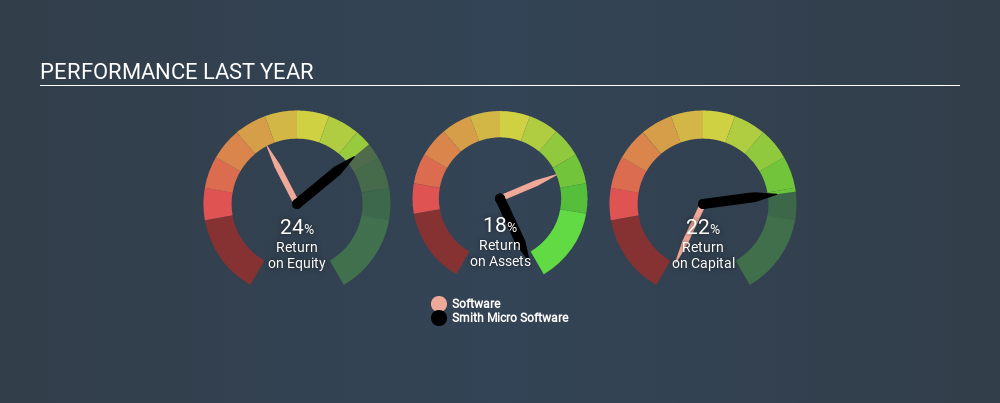- United States
- /
- Software
- /
- NasdaqCM:SMSI
Here's What Smith Micro Software, Inc.'s (NASDAQ:SMSI) ROCE Can Tell Us

Today we are going to look at Smith Micro Software, Inc. (NASDAQ:SMSI) to see whether it might be an attractive investment prospect. Specifically, we'll consider its Return On Capital Employed (ROCE), since that will give us an insight into how efficiently the business can generate profits from the capital it requires.
First up, we'll look at what ROCE is and how we calculate it. Then we'll compare its ROCE to similar companies. Last but not least, we'll look at what impact its current liabilities have on its ROCE.
Understanding Return On Capital Employed (ROCE)
ROCE is a measure of a company's yearly pre-tax profit (its return), relative to the capital employed in the business. In general, businesses with a higher ROCE are usually better quality. In brief, it is a useful tool, but it is not without drawbacks. Author Edwin Whiting says to be careful when comparing the ROCE of different businesses, since 'No two businesses are exactly alike.
How Do You Calculate Return On Capital Employed?
Analysts use this formula to calculate return on capital employed:
Return on Capital Employed = Earnings Before Interest and Tax (EBIT) ÷ (Total Assets - Current Liabilities)
Or for Smith Micro Software:
0.22 = US$13m ÷ (US$68m - US$9.0m) (Based on the trailing twelve months to March 2020.)
So, Smith Micro Software has an ROCE of 22%.
View our latest analysis for Smith Micro Software
Does Smith Micro Software Have A Good ROCE?
When making comparisons between similar businesses, investors may find ROCE useful. Smith Micro Software's ROCE appears to be substantially greater than the 9.5% average in the Software industry. We consider this a positive sign, because it suggests it uses capital more efficiently than similar companies. Putting aside its position relative to its industry for now, in absolute terms, Smith Micro Software's ROCE is currently very good.
Smith Micro Software delivered an ROCE of 22%, which is better than 3 years ago, as was making losses back then. That suggests the business has returned to profitability. You can see in the image below how Smith Micro Software's ROCE compares to its industry. Click to see more on past growth.

Remember that this metric is backwards looking - it shows what has happened in the past, and does not accurately predict the future. ROCE can be misleading for companies in cyclical industries, with returns looking impressive during the boom times, but very weak during the busts. This is because ROCE only looks at one year, instead of considering returns across a whole cycle. Since the future is so important for investors, you should check out our free report on analyst forecasts for Smith Micro Software.
How Smith Micro Software's Current Liabilities Impact Its ROCE
Short term (or current) liabilities, are things like supplier invoices, overdrafts, or tax bills that need to be paid within 12 months. Due to the way the ROCE equation works, having large bills due in the near term can make it look as though a company has less capital employed, and thus a higher ROCE than usual. To check the impact of this, we calculate if a company has high current liabilities relative to its total assets.
Smith Micro Software has total assets of US$68m and current liabilities of US$9.0m. As a result, its current liabilities are equal to approximately 13% of its total assets. This is quite a low level of current liabilities which would not greatly boost the already high ROCE.
Our Take On Smith Micro Software's ROCE
, Smith Micro Software looks strong on this analysis, but there are plenty of other companies that could be a good opportunity . Here is a free list of companies growing earnings rapidly.
I will like Smith Micro Software better if I see some big insider buys. While we wait, check out this free list of growing companies with considerable, recent, insider buying.
Love or hate this article? Concerned about the content? Get in touch with us directly. Alternatively, email editorial-team@simplywallst.com.
This article by Simply Wall St is general in nature. It does not constitute a recommendation to buy or sell any stock, and does not take account of your objectives, or your financial situation. We aim to bring you long-term focused analysis driven by fundamental data. Note that our analysis may not factor in the latest price-sensitive company announcements or qualitative material. Simply Wall St has no position in any stocks mentioned. Thank you for reading.
About NasdaqCM:SMSI
Smith Micro Software
Develops and sells software solutions to simplify and enhance the mobile experience to wireless and cable service providers in the Americas, Europe, the Middle East, and Africa.
Undervalued moderate.
Market Insights
Community Narratives





